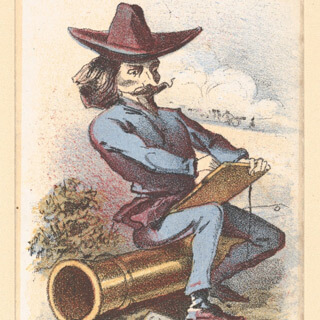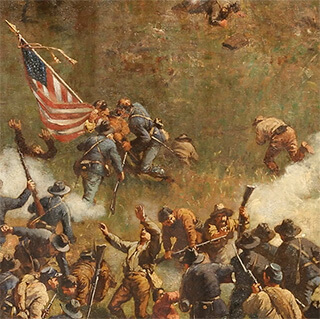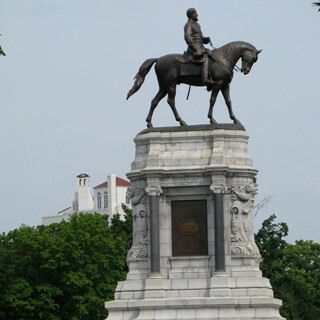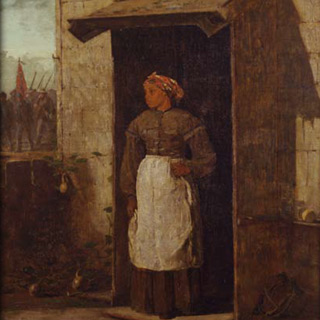Overview
David Howes reviews Mark M. Smith's The Smell of Battle, the Taste of Siege: A Sensory History of the Civil War (New York: Oxford University Press, 2014).
Review

Sensory history is an exciting new approach to writing history. It offers a fresh take on past perceptions. Sensing between the lines of written sources, the sensory historian recasts history as sense-making activity, not merely a litany of dates and deeds. Ideally, readers can feel the pulse of a given period, sniff the atmosphere, and see events in a different light.
Mark M. Smith is the doyen of sensory history in the US. In Sensing the Past: Seeing, Hearing, Smelling, Tasting, and Touching in History (Oakland: University of California Press, 2007) he laid out a manifesto for bringing history to our senses. In How Race Is Made: Slavery, Segregation, and the Senses (Chapel Hill: University of North Carolina Press, 2006) he explored the sensory dynamics of racialization in the American South. In The Smell of Battle, The Taste of Siege, he turns his attention to the Civil War.
Smith begins by evoking the antebellum sensorium offered in an 1852 essay, "The Cultivation of the Senses," published in Harper's New Monthly Magazine that portrayed the senses as shapers of character and agents of civilization, provided they were exercised properly: "[the] eye should not be injured by resting on a vulgar confusion of colors, or clumsy, ill-proportioned forms; the ear should not be falsified by discordant sounds, and harsh, unloving voices; the nose should not be a receptacle for impure odors; each sense should be preserved in its purity" (1). This preoccupation with sensory order and decorum was particularly intense in a city such as Charleston, South Carolina, built on slavery, where every social relation exhibited gradations of command and obedience. The slave did not speak unless spoken to; there was a strict curfew prohibiting movement at night; the singing of slaves at work in the fields was music to the ears of the white slaveholder.

However, the ostensibly serene city of Charleston also shivered with fear at the prospect of a slave revolt. Silence was ominous as well as golden: "If they [the slaves] want to kill us," one female diarist wrote, "they can do it when they please, they are as noiseless as panthers" (18). The senses of the white population were already on edge leading up to 1861–1864 when, as Smith puts it: "The nation that had prided itself on its civilized control of the senses lost that control" (6).
Smith's book is structured around five events, each analyzed through a different sensory modality, while at the same time noting shifts in the salience of certain sensations as the event unfolded. The effect is captivating, and generative of many insights into, for example, military tactics, survival strategies, and commemorative practices.
In "The Sounds of Secession," Smith invites readers to listen in to transformations in the Charleston soundscape from the first murmurs of dissension sparked by Abraham Lincoln's election through the "storm of cheers" that greeted the signing of the Ordinance of Secession in November 1860 to the deafening bombardment of the Union stronghold at Fort Sumter in April 1861. Thousands of Charlestonians exited their homes to witness the conflagration in the harbor: "Unused as their ears were to the appalling sounds, or the vivid flashes from the batteries, they stood for hours fascinated with horror" (33).
In "Eyeing First Bull Run," Smith discusses how commanders on both sides were preoccupied with drawing up maps, building observation towers, constructing battle lines, ordering columns, and framing engagements—that is, with visualizing the impending battle. However, the first casualty of the Manassas battlefield was the certainty of sight and seeing. Due to dense woods, billowing clouds of dust and smoke, and dilapidated uniforms, it quickly proved impossible for the soldiers to keep in line, or to distinguish friend from foe. Many resorted to shooting blind. Somehow the Confederate forces prevailed, perhaps on account of their oft-remarked spine-tingling rebel yell.

Incidents of the war. A harvest of death, Gettysburg, Pennsylvania, July 1863. Photograph by Timothy H. O'Sullivan. Courtesy of Wikimedia Commons. Image is in public domain.
Smith surveys the carnage at the Battle of Gettysburg, documented by the new technology of photography. The sensation that made the most lasting impression, however, was not that of sight but of stench. As one female diarist wrote:
Not the presence of the dead bodies themselves, swollen and disfigured as they were and lying in heaps on every side was as awful to the spectator as that deadly, nauseating atmosphere which robbed the battlefield of its glory, the survivors of their victory and the wounded of what little chance of life was left to them . . . A sickening, overpowering, awful stench announced the presence of the unburied dead upon which the July sun was mercilessly shining and at every step the air grew heavier and fouler until it seemed to possess a palpable horrible density that could be seen and felt and cut with a knife. (79)
Gettysburg was a "degenerative moment," Smith writes (7). It would take many grandiloquent speeches and solemn reconciliatory gestures to dispel the miasma and make it stand for something meaningful, a turning point.
Examining the Union siege of Vicksburg, Smith tells a harrowing tale of a city "taken by hunger." The Union forces under Grant dug in around the base of the terraced city, and kept up a constant bombardment of "shistling" bullets and pounding shells. Residents found shelter in newly dug caves, which provided a limited defense, and took a toll on the residents' comfort and dignity. "We went in this evening and sat down," one diarist wrote, and "the earthy, suffocating feeling, as of a living tomb, was dreadful to me. I fear I shall risk death outside rather than melt in that dark furnace" (98). Besides being reduced to a "troglodyte existence," the residents' diet was reduced and reduced again to "spoiled greasy bacon and bread made of musty pea-flour" (110). Ignominy as much as starvation precipitated surrender.


In the final chapter, Smith delves into the H.L. Hunley, a proud piece of Confederate technology, designed to break the US Navy's blockade of Charleston Harbor. The Hunley was an "underwater machine" consisting of a forty-foot-long refitted boiler (forty-eight inches in diameter) in which eight men turned cranks attached to the propeller shaft. A long arm protruded from the front of the vessel with a torpedo attached to its tip. Smith makes much of the cramped quarters, which imposed an unnatural proximity, and of the cranks' constant turning, which was reminiscent of slaves ginning cotton: "The Hunley men weren't slaves [they were volunteers], but they . . . willingly placed themselves in the condition of slaves—in the fight to preserve slavery" (128). Thanks to its underwater stealth, the Hunley succeeded at torpedoing and sinking the USS Housatonic, sowing great consternation, even though the entire crew drowned at their stations. This experiment in underwater warfare was not repeated.
Smith's epilogue revisits General Sherman's March, a swath of destruction up to sixty miles wide through the Confederate heartland, assaulting senses and resources, doling deprivation and misery while laying waste to buildings and crops in an effort to break Confederate will. Particularly loathsome to the defeated Southerners was the sight of the Union flag and the riling notes of "Yankee Doodle," not to mention the taunts. "Did you ever think of this when you hurrahed for Secession?" one Union soldier asked a white man in Columbia, as he gestured to the flames engulfing the city. "Your mouth is silenced now and it is worth every damn year of this bloody war. How do you like it, hey?" (144–45).

Smith's sensory history of the Civil War brings a dramatic new perspective to bear on this transformative event that gave rebirth to a nation. He tells a compelling story, based on diaries, letters, and other archival material. A number of questions remain unanswered, however. What of the sounds and expressions of the enslaved when out of earshot of the slaveowners? What did singing mean to them, and what messages did the songs convey? Smith has touched on these questions elsewhere, in Listening to Nineteenth-Century America (Chapel Hill: University of North Carolina Press, 2001), for example, but he does not address them in this book. For that, one might start with Lawrence W. Levine's Black Culture and Black Consciousness (New York: Oxford University Press, 1978). Levine succeeds at rendering the inaudible sensible in ways that Smith does not, for Smith's book is more a "history from above" (attuned to the anxious perceptions of the dominant society) than "from below" (attentive to the sonic and other practices of persistence and resistance of the subaltern).
The Smell of Battle, the Taste of Siege is a foundational work, both in sensory history and in the emergent field of conflict and the senses.1 Nicholas J. Saunders and Paul Cornish, eds., Modern Conflict and the Senses (New York: Routledge, 2017). It yields many important insights into the lived experience of the Civil War, and is certain to inspire further research into what ranks as the most traumatic event in US history. 
About the Author
David Howes is a professor of Anthropology and Director of the Centre for Sensory Studies at Concordia University, Montreal. He is also the Director of the Concordia Centre for Interdisciplinary Studies in Society and Culture (CISSC). He teaches courses on law, commerce, aesthetics, and the senses in cross-cultural perspectives.
Recommended Resources
Text
"The Cultivation of the Senses." Harper's New Monthly Magazine 6, no. 31 (1852): 81.
Howes, David and Constance Classen. Ways of Sensing: Understanding the Senses in Society. New York: Routledge, 2014.
Levine, Lawrence W. Black Culture and Black Consciousness: Afro-American Folk Thought from Slavery to Freedom. New York: Oxford University Press, 1978.
McWhirter, Christian. Battle Hymns: The Power and Popularity of Music in the Civil War. Chapel Hill: University of North Carolina Press, 2012.
Roeder, George H. Jr. "Coming to Our Senses." The Journal of American History 81, no. 3 (1994): 1112–1122.
Smith, Andrew F. Starving the South: How the North Won the Civil War. New York: St. Martin's Press, 2011.
Smith, Mark M. How Race Is Made: Slavery, Segregation and the Senses. Chapel Hill: University of North Carolina Press, 2006.
———. Listening to Nineteenth-Century America. Chapel Hill: University of North Carolina Press, 2001.
———. Sensing the Past: Seeing, Hearing, Smelling, Tasting, and Touching in History. Oakland: University of California Press, 2007.
———. "Still Coming to 'Our' Senses: An Introduction." The Journal of American History 95, no. 2 (2008): 378–380.
Web
Horwitz, Tony. "150 Years of Misunderstanding the Civil War." The Atlantic. June 19, 2013. https://www.theatlantic.com/national/archive/2013/06/150-years-of-misunderstanding-the-civil-war/277022/.
Howes, David. "The Expanding Field of Sensory Studies." Sensory Studies. August 2013. http://www.sensorystudies.org/sensorial-investigations/the-expanding-field-of-sensory-studies/.
Lovell, Abbey. "The Civil War in five senses." OUPblog. Blog. November 13, 2014. https://blog.oup.com/2014/11/civil-war-sensory-history/.
Seven-Millionth Volume: Gardner's Photographic Sketch Book of the War. Division of Rare and Manuscript Collections, Cornell University Library (Ithaca, New York). 2002–2017. http://rmc.library.cornell.edu/7milVol/index.html.
Similar Publications
| 1. | Nicholas J. Saunders and Paul Cornish, eds., Modern Conflict and the Senses (New York: Routledge, 2017). |
|---|




